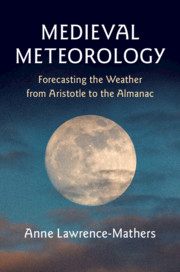Book contents
- Medieval Meteorology
- Medieval Meteorology
- Copyright page
- Contents
- Preface
- Acknowledgements
- Introduction
- 1 Recreating Meteorology in the Early Middle Ages
- 2 Meteorology, Weather Forecasting and the Early Medieval Renaissance of Astronomy
- 3 Exploratory Encounters with the Work of Arab Astronomers and Meteorologists
- 4 Meteorology, the New Science of the Stars and the Rise of Weather Forecasting
- 5 The Contested Rise of Astrometeorology
- 6 Applying the Science of Astrometeorology
- 7 Astrometeorology and Mechanisation
- 8 Weather Forecasting and the Impact of Print
- Conclusion
- Bibliography
- Index
Introduction
Ancient Meteorology and the Transition to the Middle Ages
Published online by Cambridge University Press: 08 November 2019
- Medieval Meteorology
- Medieval Meteorology
- Copyright page
- Contents
- Preface
- Acknowledgements
- Introduction
- 1 Recreating Meteorology in the Early Middle Ages
- 2 Meteorology, Weather Forecasting and the Early Medieval Renaissance of Astronomy
- 3 Exploratory Encounters with the Work of Arab Astronomers and Meteorologists
- 4 Meteorology, the New Science of the Stars and the Rise of Weather Forecasting
- 5 The Contested Rise of Astrometeorology
- 6 Applying the Science of Astrometeorology
- 7 Astrometeorology and Mechanisation
- 8 Weather Forecasting and the Impact of Print
- Conclusion
- Bibliography
- Index
Summary
This chapter provides definitions of contrasting classical and medieval approaches to meteorology. It outlines the relevant works of Aristotle, as well as the means by which selections from these were transferred to Roman writers. The roles of Pliny and Virgil are considered, together with their own reception by early medieval writers. A key point is that patristic writers, especially Augustine, integrated this knowledge of the natural world into Christian teachings on cosmology. However, Aristotle’s arguments on meteorology were primarily transmitted to Latin Europe in Islamicate versions, and came accompanied by new information on astronomy. The chapter then offers an account of the transition from classical, theoretical models of climate to more detailed calculation of planetary movements and their alleged meteorological effects. An important argument is that early medieval scientific work is often presented in diagrams and tables, themselves found in monastic works on the ecclesiastical year, and are easy to miss or underestimate.
Keywords
- Type
- Chapter
- Information
- Medieval MeteorologyForecasting the Weather from Aristotle to the Almanac, pp. 1 - 16Publisher: Cambridge University PressPrint publication year: 2019



